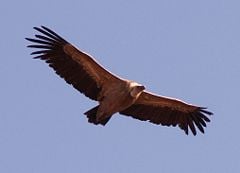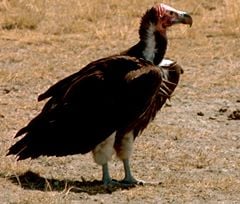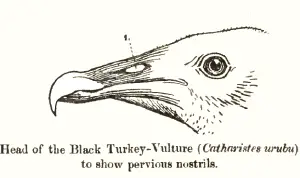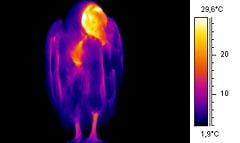Difference between revisions of "Vulture" - New World Encyclopedia
Rick Swarts (talk | contribs) |
Rick Swarts (talk | contribs) |
||
| Line 13: | Line 13: | ||
| subdivision = | | subdivision = | ||
[[Falconiformes]] (Fam. [[Accipitridae]] (part))<br> | [[Falconiformes]] (Fam. [[Accipitridae]] (part))<br> | ||
| − | [[Ciconiiformes]] (Fam. [[Cathartidae]]) | + | [[Ciconiiformes]] (Fam. [[Cathartidae]] (part)) |
}} | }} | ||
[[Image:Vulture 19o05.jpg|right|240px|thumb|Griffon Vulture soaring]] | [[Image:Vulture 19o05.jpg|right|240px|thumb|Griffon Vulture soaring]] | ||
| − | ''' | + | '''Vulture''' is the common name for various large birds of prey within the family Cathartidae (New World vultures) and the family Accipitridae (Old World vultures), typically characterized by a featherless head, keen sight, good soaring ability, and generally [[scavenger|scavenging]] behavior, feeding mostly on the carcasses of dead [[animal]]s. Vultures are found in every continent except [[Antarctica]] and [[Oceania]]. |
| + | |||
| + | The Old World Vultures are in the same family as [[eagle]]s, [[buzzard]]s and [[hawk]]s, while the New World Vultures are in the same family as [[condor]]s, and are closely related to [[stork]]s. | ||
A particular characteristic of many vultures is a bald [[head (anatomy)|head]], devoid of [[feather]]s. This is likely because a feathered head would become spattered with [[blood]] and other fluids, and thus be difficult to keep clean. | A particular characteristic of many vultures is a bald [[head (anatomy)|head]], devoid of [[feather]]s. This is likely because a feathered head would become spattered with [[blood]] and other fluids, and thus be difficult to keep clean. | ||
| Line 24: | Line 26: | ||
==Classification== | ==Classification== | ||
| − | Vultures are classified into two groups: Old World vultures and New World vultures. The similarities between the two different groups are due to [[convergent evolution]]. | + | Vultures are classified into two groups: Old World vultures and New World vultures. These are not closely related and are sometimes placed in different orders, although traditionally they have both been placed in the Falconiformes order. The similarities between the two different groups are due to [[convergent evolution]]. |
===Old World vultures=== | ===Old World vultures=== | ||
| − | + | [[Image:Nubianvulture.jpeg|thumb|right|240px|Old World vulture: Nubian Vulture or Lappet-faced Vulture]] | |
| − | The [[Old World vulture]]s found in [[Africa]], [[Asia]] and [[Europe]] belong to the family [[Accipitridae]], which also includes [[eagle]]s, [[kite (bird)|kites]], [[buzzard]]s and [[hawk]]s. Old World vultures find carcasses exclusively by sight. | + | The [[Old World vulture]]s, found in [[Africa]], [[Asia]] and [[Europe]], belong to the family [[Accipitridae]], which also includes [[eagle]]s, [[kite (bird)|kites]], [[buzzard]]s, and [[hawk]]s. Old World vultures find carcasses exclusively by sight. |
| − | + | Old World vultures, which are not closely related to the superficially similar [[New World vulture]]s and [[condor]]s, do not share that group's good sense of smell. As scavenging [[bird]]s, feeding mostly from carcasses of dead [[animal]]s, Old World vultures find carcasses exclusively by sight. | |
| − | |||
| − | |||
| − | |||
| − | |||
| − | |||
| − | |||
| − | |||
| − | |||
| − | |||
| − | |||
| − | |||
| − | |||
| − | |||
| − | |||
| − | |||
| − | + | Old World vultures include 16 species scattered within nine [[genus|genera]] within the Accipitridae family: | |
| − | + | *Genus ''Aegypius'' | |
| − | + | ** [[Eurasian black vulture]] or monk vulture, ''Aegypius monachus'' | |
| − | + | *Genus ''Gypaetus'' | |
| − | + | ** [[Lammergeier]] or bearded vulture, ''Gypaetus barbatus'' | |
| − | + | *Genus ''Gypohierax'' | |
| − | + | ** [[Palm-nut vulture]], ''Gypohierax angolensis'' | |
| − | + | *Genus ''Gyps'' | |
| − | + | ** [[Griffon vulture]] ''Gyps fulvus'' | |
| − | '' | + | ** [[Indian white-rumped vulture]], ''Gyps bengalensis'' |
| − | * [[Eurasian | + | ** [[Rüppell's vulture]], ''Gyps rueppelli'' |
| − | '' | + | ** [[Long-billed vulture]] ''Gyps indicus'' |
| − | * [[Lammergeier]] or | + | ** [[Slender-billed vulture]] ''Gyps tenuirostris'' |
| − | '' | + | ** [[Himalayan griffon vulture]] ''Gyps himalayensis'' |
| − | * [[Palm-nut | + | ** [[White-backed vulture]], ''Gyps africanus'' |
| − | '' | + | ** [[Cape griffon]], ''Gyps coprotheres'' |
| − | * [[Griffon | + | *Genus ''Necrosyrtes'' |
| − | * [[Indian | + | ** [[Hooded vulture]], ''Necrosyrtes monachus'' |
| − | * [[Rüppell's | + | *Genus ''Neophron'' |
| − | * [[Long-billed | + | ** [[Egyptian vulture]], ''Neophron percnopterus'' |
| − | * [[Slender-billed | + | *Genus ''Sarcogyps'' |
| − | * [[Himalayan | + | ** [[Red-headed vulture]], ''Sarcogyps calvus'' |
| − | * [[White-backed | + | *Genus ''Torgos'' |
| − | * [[Cape | + | ** [[Lappet-faced Vulture]], ''Torgos tracheliotus'' |
| − | '' | + | *Genus ''Trigonoceps'' |
| − | * [[Hooded | + | **[[White-headed vulture]], ''Trigonoceps occipitalis'' |
| − | '' | ||
| − | * [[Egyptian | ||
| − | '' | ||
| − | * [[Red-headed | ||
| − | '' | ||
| − | * [[Lappet-faced Vulture]], ''Torgos tracheliotus'' | ||
| − | '' | ||
| − | * [[White-headed | ||
| − | |||
| − | |||
| − | |||
===New World vultures=== | ===New World vultures=== | ||
| Line 170: | Line 146: | ||
* [http://news.bbc.co.uk/1/hi/sci/tech/4670736.stm NSAID effects on vultures (BBC website)] | * [http://news.bbc.co.uk/1/hi/sci/tech/4670736.stm NSAID effects on vultures (BBC website)] | ||
* "India's Vultures Fall Prey to a Drug in the Cattle They Feed On", New York Times, Amelia Gentleman, March 28, 2006. | * "India's Vultures Fall Prey to a Drug in the Cattle They Feed On", New York Times, Amelia Gentleman, March 28, 2006. | ||
| + | |||
| + | <!--- Biochemical Systematics and Ecology 29 (2001) 485–512 Allozyme variation in four populations of African whitebacked vultures (Gyps africanus) and phylogenetic relationships between four vulture species from southern Africa | ||
| + | Erika van Wyka, Herman van der BankCorresponding Author Contact Information, E-mail The Corresponding Author, a and Gerhard H. Verdoornb | ||
| + | |||
| + | |||
==External links== | ==External links== | ||
| Line 178: | Line 159: | ||
[[Category:Animals]] | [[Category:Animals]] | ||
[[Category:Birds]] | [[Category:Birds]] | ||
| − | {{credit|Vulture|174226177}} | + | {{credit|Vulture|174226177|Old_World_vulture|175773129}} |
Revision as of 17:11, 6 December 2007
| 'Vultures' | ||||||
|---|---|---|---|---|---|---|
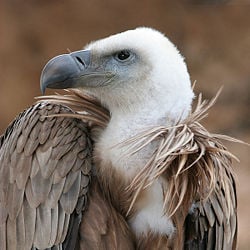 Griffon vulture, Gyps fulvus
| ||||||
| Scientific classification | ||||||
| ||||||
|
Falconiformes (Fam. Accipitridae (part)) |
Vulture is the common name for various large birds of prey within the family Cathartidae (New World vultures) and the family Accipitridae (Old World vultures), typically characterized by a featherless head, keen sight, good soaring ability, and generally scavenging behavior, feeding mostly on the carcasses of dead animals. Vultures are found in every continent except Antarctica and Oceania.
The Old World Vultures are in the same family as eagles, buzzards and hawks, while the New World Vultures are in the same family as condors, and are closely related to storks.
A particular characteristic of many vultures is a bald head, devoid of feathers. This is likely because a feathered head would become spattered with blood and other fluids, and thus be difficult to keep clean.
A group of vultures is occasionally called a venue, and when circling in the air a group of vultures is called a kettle. The word Geier (taken from the German language) does not have a precise meaning in ornithology, and it is occasionally used to refer to a vulture in English, as in some poetry.
Classification
Vultures are classified into two groups: Old World vultures and New World vultures. These are not closely related and are sometimes placed in different orders, although traditionally they have both been placed in the Falconiformes order. The similarities between the two different groups are due to convergent evolution.
Old World vultures
The Old World vultures, found in Africa, Asia and Europe, belong to the family Accipitridae, which also includes eagles, kites, buzzards, and hawks. Old World vultures find carcasses exclusively by sight.
Old World vultures, which are not closely related to the superficially similar New World vultures and condors, do not share that group's good sense of smell. As scavenging birds, feeding mostly from carcasses of dead animals, Old World vultures find carcasses exclusively by sight.
Old World vultures include 16 species scattered within nine genera within the Accipitridae family:
- Genus Aegypius
- Eurasian black vulture or monk vulture, Aegypius monachus
- Genus Gypaetus
- Lammergeier or bearded vulture, Gypaetus barbatus
- Genus Gypohierax
- Palm-nut vulture, Gypohierax angolensis
- Genus Gyps
- Griffon vulture Gyps fulvus
- Indian white-rumped vulture, Gyps bengalensis
- Rüppell's vulture, Gyps rueppelli
- Long-billed vulture Gyps indicus
- Slender-billed vulture Gyps tenuirostris
- Himalayan griffon vulture Gyps himalayensis
- White-backed vulture, Gyps africanus
- Cape griffon, Gyps coprotheres
- Genus Necrosyrtes
- Hooded vulture, Necrosyrtes monachus
- Genus Neophron
- Egyptian vulture, Neophron percnopterus
- Genus Sarcogyps
- Red-headed vulture, Sarcogyps calvus
- Genus Torgos
- Lappet-faced Vulture, Torgos tracheliotus
- Genus Trigonoceps
- White-headed vulture, Trigonoceps occipitalis
New World vultures
The New World vultures and condors found in warm and temperate areas of the Americas are not closely related to the superficially similar Accipitridae, but belong in the family Cathartidae, which is quite close to the storks. Several species have a good sense of smell, unusual for raptors.
| New World vultures | ||||||||||
|---|---|---|---|---|---|---|---|---|---|---|
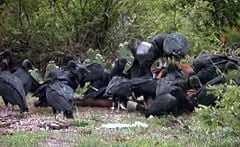 American Black Vultures on a cow carcass
| ||||||||||
| Scientific classification | ||||||||||
| ||||||||||
|
Coragyps |
The New World vulture family Cathartidae contains seven species found in warm and temperate areas of the Americas. It includes five vultures and two condors. Excluding Cathartes, all genera are monotypic.
New World vultures are not closely genetically related to the superficially similar family of Old World vultures, the similarities between the two groups of vultures being due to convergent evolution. They were widespread in both the Old World and North America, during the Neogene.
Vultures are scavenging birds, feeding mostly from carcasses of dead animals. New World vultures have a good sense of smell, but Old World vultures find carcasses exclusively by sight. A particular characteristic of many vultures is a bald head, devoid of feathers.
New World vulture biology
Taxonomy and evolution
The New World vultures comprise seven species in five genera. The genera are Coragyps, Cathartes, Gymnogyps, Sarcoramphus, and Vultur. Of these, only Cathartes is not monotypic.
Although New World vultures have many resemblances to Old World vultures (traditionally considered part of the bird-of-prey order Falconiformes, though now often classified in a different order[citation needed]), they are not very closely related. Rather, they resemble Old World vultures because of convergent evolution.
New World vultures were traditionally placed in a family of their own in the Falconiformes.[1] However, in the late 20th century some ornithologists argued that they are more closely related to storks on the basis of karyotype,[2] morphological,[3] and behavioral[4] data. Thus some authorities place them in the Ciconiiformes with the storks and herons; Sibley and Monroe (1990) even considered them a subfamily of the stork family. This has been criticized as an oversimplification,[5][6] and recently genetic evidence has been presented against it.[7][8] Consequently, there is a recent trend to raise the New World vultures to the rank of an independent order Cathartiformes not closely associated with either birds of prey or storks or herons.[9] In 2007 the American Ornithologists' Union's North American checklist moved Cathartidae back into the lead position in Falconiformes [10]. The AOU's draft South American checklist calls the Cathartidae incertae sedis (of uncertain position) rather than placing it any order.[11] The name Cathartidae comes from cathartes, Greek for "purifier".
Morphology
These birds are generally large, ranging in length from the Lesser Yellow-headed Vulture at 56–61 centimeters (22–24 in) up to the California and Andean Condors, both of which can reach 120 centimeters (48 in) in length and weigh 12 or more kilograms (26 or more lb). Plumage is predominantly black or brown, and is sometimes marked with white. All species have featherless heads and necks.[12] In some, this skin is brightly colored, and in the King Vulture it is developed into colorful wattles and outgrowths.
All species have long, broad wings and a stiff tail, suitable for soaring.[13] They are the best adapted to soaring of all land birds.[14] The feet are clawed but weak and not adapted to grasping.[15] The front toes are long with small webs at their bases.[16] No New World vulture possesses a syrinx,[17] the vocal organ of birds, therefore the voice is limited to infrequent grunts and hisses.[18]
The beak is slightly hooked and is relatively weak when compared those of other birds of prey.[19] It weak because it is adapted to tear the weak flesh of partially rotted carrion, rather than fresh meat.[20] The nostrils are oval and are set in a soft cere.[21] The nasal passage is not divided by a septum (they are "perforate"), so from the side one can see through the beak,[22] as in the Turkey Vulture. The eyes are prominent, and unlike those of eagles, hawks and falcons, they are not shaded by a bony brow bone.[23] Members of Coragyps and Cathartes have a single incomplete row of eyelashes on the upper lid and two rows on the lower lid, while Gymnogyps, Vultur, and Sarcoramphus lack eyelashes altogether.[24]
New World vultures have the unusual habit of urohidrosis, or defecating on their legs to cool them evaporatively. As this behavior is also present in storks, it is one of the arguments for a close relationship between the two groups.[25]
Diet
All living species of New World vultures and condors are scavengers. Though their diet is overwhelmingly composed of carrion, some species such as the American Black Vulture have been recorded as killing live prey. Other additions to the diet include fruit, eggs, and garbage. An unusual characteristic of the species in genus Cathartes is a highly developed sense of smell, which they use to find carrion. They locate carrion by detecting the scent of ethyl mercaptan, a gas produced by the beginnings of decay in dead animals. The olfactory lobe of the brains in these species, which is responsible for processing smells, is particularly large compared to that of other animals.[26] Other species such as the American Black Vulture and the King Vulture have weak senses of smell and find food only by sight, sometimes by following Cathartes vultures and other scavengers.[27] The head and neck of New World Vultures are featherless as an adaptation for hygiene; this lack of feathers prevents bacteria from the carrion it eats from ruining its feathers and exposes the skin to the sterilizing effects of the sun.[28]
New_World_vulture&oldid=176069708
Feeding
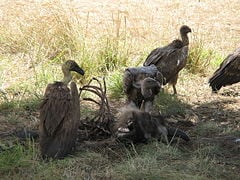
Vultures seldom attack healthy animals, but may kill the wounded or sick. Vast numbers have been seen upon battlefields. They gorge themselves when prey is abundant, till their crop bulges, and sit, sleepy or half torpid, to digest their food. They do not carry food to their young in their claws, but disgorge it from the crop. These birds are of great value as scavengers, especially in hot regions. They can eat rotten flesh containing anthrax, botulism, and cholera bacteria, which are destroyed in the stomach [1].
Threat due to diclofenac poisoning
The vulture population in India and Pakistan has declined by up to 95% recently in the past decade, and two or three of the species of vulture in South Asia are nearing extinction. This has been caused by the practice of giving working farm animals diclofenac, which is a non-steroidal anti-inflammatory drug (NSAID) with anti-inflammatory and pain killing actions. Diclofenac administration keeps animals that are ill or in pain working on the land for longer, but, if the ill animals die, their carcasses contain diclofenac. Farmers leave the dead animals out in the open, relying on vultures to tidy up. Diclofenac present in carcass flesh is eaten by the vultures, which are sensitive to diclofenac, suffering kidney failure, visceral gout, and death as a result of diclofenac poisoning.
The decline in vultures has led to hygiene problems in India as carcasses of dead animals now tend to rot, or be eaten by rats or wild dogs, rather than be tidied up by vultures. Rabies among these scavengers is a major health threat. India has the world's highest rate of rabies.
The decline in vultures causes particular problems for certain communities, such as the Parsi, who practice sky burials, where the human dead are put on the top of Towers of Silence and are eaten by vultures, leaving only dry bones.
Meloxicam (another NSAID) has been found to be harmless to vultures and should prove an acceptable alternative to diclofenac. The Government of India banned diclofenac, but it continues to be sold over a year later and is still a problem in other parts of the world.[2]
Vultures in culture
Ancient Egypt
In Southern Africa, the name for a Nubian vulture is synonymous with the term applied to lovers, because these vultures are always seen in pairs, mother and child remaining closely bonded together. Pairing, bonding, protecting, and loving are essential attributes associated with the vulture's size and its ability to soar high up in the sky. The Egyptians considered the vulture an excellent mother, and its wide wingspan was seen as all-encompassing and providing a protective cover to its infants. The vulture hieroglyph
| |
was the uniliteral sign used for the glottal sound (3) including words such as mother, prosperous, grandmother, and ruler
In the Western world, the image of the vulture is far more negative, with 'vulture' used as a metaphor for those who prey on the weak or dying, with associated negative connotations of cowardice and selfishness (although the vulture plays an important natural role).
ReferencesISBN links support NWE through referral fees
- Ferguson-Lees, Christie, Franklin, Mead and Burton Raptors of the World ISBN 0713680261
- Grimmett, Inskipp and Inskipp, Birds of India ISBN 0-691-04910-6
- Hilty, Birds of Venezuela, ISBN 0-7136-6418-5
- Ian Sinclair, Phil Hockey and Warwick Tarboton, SASOL Birds of Southern Africa (Struik 2002) ISBN 1-86872-721-1
- NSAID effects on vultures (BBC website)
- "India's Vultures Fall Prey to a Drug in the Cattle They Feed On", New York Times, Amelia Gentleman, March 28, 2006.
- ↑ Sibley and Ahlquist (1991)
- ↑ de Boer (1975)
- ↑ Ligon (1967)
- ↑ König (1982)
- ↑ Griffiths (1994)
- ↑ Fain & Houde (2004)
- ↑ Cracraft et al. (2004)
- ↑ Gibb et al. (2007)
- ↑ Ericson et al. (2006)
- ↑ American Ornithologists' Union (2007)
- ↑ Remsen et al. (2007)
- ↑ Zim et al (2001)
- ↑ Reed (1914):p. 198
- ↑ Ryser & Ryser (1985):p. 211
- ↑ Krabbe (1990):p. 88
- ↑ Feduccia (1999)
- ↑ Kemp and Newton (2003):p. 146
- ↑ Howell and Webb (1995)
- ↑ Krabbe (1990):p. 88
- ↑ Ryser & Ryser (1985):p. 211
- ↑ Terres (1991):p 957
- ↑ Allaby (1992)
- ↑ Terres (1991):p 957
- ↑ Fisher (1942)
- ↑ Sibley and Ahlquist (1991)
- ↑ Snyder (2006):p 40
- ↑ Kemp and Newton (2003):p. 147
- ↑ Sarcoramphus papa. Who Zoo. Retrieved 2007-09-11.
